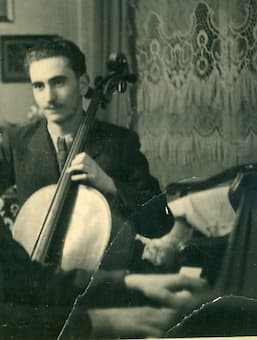
Janet’s father George Horvath in 1930s
Recently, I listened to the soothing and beautiful classical music pieces my father used to play. I immediately teared up! Some exquisite works seem to have gone out of fashion. I’d love to introduce you to several cello pieces that my father often performed.
Franz Joseph Haydn: Divertimento in D
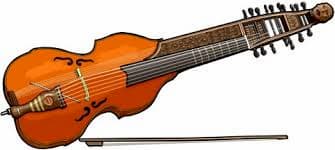
Baryton
Franz Joseph Haydn (1732-1809) wrote for his employer Prince Nikolaus of the legendary Esterházy family including 123 trios for viola, cello, and baryton (a rare bowed instrument with frets.) One of the trios was arranged for cello and piano by the famed Russian cellist Gregor Piatigorsky, recreated by combining music from the baryton and viola parts. The result is the Divertimento in D, a lovely work in three short movements, perfect for starting a program. The opening movement, a melodious Adagio, is followed by the enchanting Menuet and Trio, and a flashy Allegro last movement. In a short nine minutes, one takes a journey from the soothing serenade to an animated finale. It’s a delightful piece.
Franz Joseph Haydn: Divertimento (arr. G. Piatigorsky from Baryton Trio) (Mihaly Virizlay, cello; Rebecca Penneys, piano)
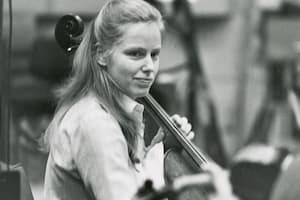
Jacqueline du Pré
Johann Sebastian Bach: Two Adagios from BWV 564 and 974
Arguably the most famous composer from the Baroque era, Johann Sebastian Bach (1685–1750) wrote more slower works than fugues and contrapuntal music! These two poetic Adagios attest to his expressive and romantic writing. The first, the Adagio from the Toccata in C, BWV 564, performed here by the brilliant cellist Jacqueline du Pré, is from a 1962 recital. Du Pré makes times stand still with her playing.
Bach and Alessandro Marcello (1669–1747) were contemporaries. The second movement of Marcello’s oboe concerto is a heavenly Adagio. J.S. Bach loved it so much that he transcribed it for harpsichord and featured the melody in his Concerto in D minor BWV 974. The adagio on the cello is exquisite. My father played both of these adagios.
Tomaso Antonio Vitali: Chaconne
Another work from that era, which captured the imaginations of composers, is Tomaso Antonio Vitali’s (1663-1745) arresting Chaconne in G minor. The opening piano chords sets up a majestic mood after which the cello enters with a striking melody. The form of the chaconne is such that the melody is repeated with several variations. The piece takes us on an excursion through several keys and brilliant reiterations. Despite its beauty the Chaconne went out of favor with performers. The transcription below has Paganini-esque pyro-techniques in the middle, and the finale reiteration of the theme is brilliant in the very highest range of the cello. There’s a marvelous version performed by the iconic violinist Jascha Heifetz with organ accompaniment, and it’s three minutes shorter!
Girolamo Alessandro Frescobaldi: Toccata
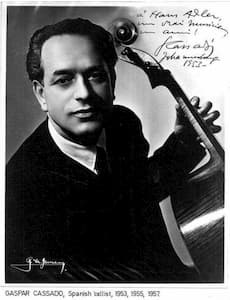
Gaspar Cassadó
It was thought that Girolamo Frescobaldi (1583-1643), the late Renaissance keyboard composer from Italy, wrote a notable Toccata, and the Spanish cellist and composer Gaspar Cassadó arranged it for cello and piano. Some doubt has been cast on the originality of the work as the manuscript has never been found. Assuming Cassadó actually composed the piece in “Frescobaldi-style”, nonetheless it opens with a touching Adagio, then morphs into a spirited and proud section full of impressive passage work, and resounding chords, after which the adagio returns, surely taking our minds off life’s daily concerns.
Girolamo Alessandro Frescobaldi: Toccata (arr. G. Cassadó for cello and piano) (Leonid Gorokhov, cello; Bobby Chen, piano)
Claude Debussy/Sally Beamish: Reverie

Claude Debussy
Debussy (1862-1918) Rêverie, is a ravishing, impressionistic work. The cello version of the song is usually played with piano accompaniment. British composer Sally Beamish did cellists a favor and arranged several of Debussy’s songs including Rêverie into an enchanting Suite for Cello and Orchestra. Born in London, Beamish is a string player herself, so her writing is perfect for the cello as well. Dream on!
Sally Beamish: Suite for Cello and Orchestra (after C. Debussy) – II. Reverie (Steven Isserlis, cello; Tapiola Sinfonietta; Gábor Takács-Nagy, cond.)
Paul Ben-Haim: Songs without Words
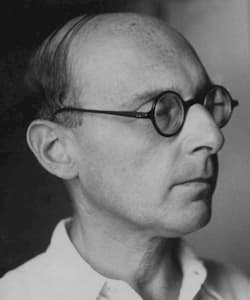
Paul Ben-Haim
Three Songs Without Words by Israeli composer Paul Ben-Haim (1897-1984) for voice or instrument and piano was introduced to me by my father and I play them often. The composer, born in Munich, became a conducting protégé of Bruno Walter. When the Nazi regime came to power in Germany he lost his position and he fled to Palestine in 1933. A conductor, pianist, and teacher he became one of Israel’s best-known composers. Ben-Haim indicates the Arioso depicts, “the bare hills of Judea under a pitiless summer sun,” and with its melancholy harmonies and steady walking rhythm in the piano we wander through the wilderness. All three movements are replete with colorful aromas and unusual harmonies.
Paul Ben-Haim: Songs without Words – No. 1. Arioso (Coenraad Bloemendal, cello; Valerie Tryon, piano)
Zoltán Kodály: Romance lyrique
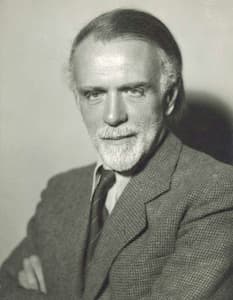
Zoltán Kodály
Hungarian music is in our blood so my father played a great deal of Kodály and Bartók. Romance Lyrique by Zoltán Kodály (1882-1967) from 1898 is a gem. It begins quite optimistically, simply, in the major key and the rich middle range of the cello. The melody intensifies and dramatic pauses add intensity. After a surprise solo cadenza, the original genial melody returns lulling us back to serenity.
Zoltán Kodály: Romance lyrique (Miklós Perényi, cello; Dénes Várjon, piano)
Alberto Ginastera: Triste
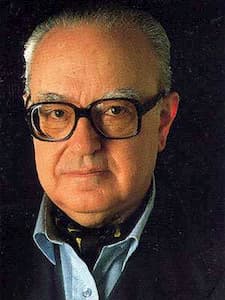
Alberto Ginastera
Argentinian composer Alberto Ginastera (1916-1983) Triste, from his 5 Canciones populares argentinas, Op. 10: No. 2, was arranged by Pierre Fournier for cello and piano. In three minutes, it captures desolation, its wistful repeated motif in the piano as if calling from afar; and with a delicate singing melody, harmonics, or whistling sounds, the cello fades away. Listen also to the original for voice with cello octet. Gorgeous.
Alberto Ginastera: 5 Canciones populares argentinas, Op. 10 – No. 2. Triste (arr. P. Fournier for cello and piano) (Leonid Gorokhov, cello; Bobby Chen, piano)
Alberto Ginastera: 5 Canciones populares argentinas, Op. 10 (arr. for mezzo-soprano and cello octet) – No. 2. Triste (Elena Gragera, mezzo-soprano; Cello Octet Conjunto Iberico; Elias Arizcuren, cond.)
Frédéric Chopin: Cello Sonata in G Minor
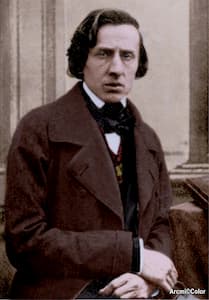
Frédéric Chopin
The Cello Sonata in G Minor Op. 65, Frédéric Chopin’s (1810-1849) last major work, was composed in 1845-46. Chopin of course is known for his many beautiful pieces for the piano. The cello is the only other instrument for which he composed anything substantial. Chopin himself premiered the work in Paris with the French cellist Auguste Franchomme, and what a success it was—Chopin’s last performance. The Largo movement is one of the most tender, beautiful, and soothing movements in our literature.
We hope these beautiful cello pieces ease you gently into 2021.
For more of the best in classical music, sign up to our E-Newsletter
Frédéric Chopin: Cello Sonata in G Minor, Op. 65 – III. Largo (Johannes Moser, cello; Ewa Kupiec, piano)



